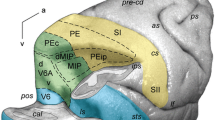Summary
Field potentials on the surface and at 2.5–3.0 mm depth in the cerebral cortex were recorded in various areas with chronically implanted electrodes and the potentials which preceded hand movements in response to a light stimulus were observed during the process of learning the skilled conditioned movement. A naive monkey had to lift a lever by wrist extension within duration of the light stimulus lasting for 900, 700 or 510 ms depending on the stage of the learning process.
In addition to some responses in the striate gyrus, significant short-latency responses to the light stimulus appeared bilaterally in certain areas of the prefrontal and prestriate cortices at an early stage of learning in which the monkey still lifted the lever randomly, and they became gradually larger as the monkey was trained further. Short-latency responses were also often noted in the bilateral premotor cortices during an early stage of learning.
When the monkey started to respond to the stimulus by the appropriate movement, early surface-positive (s-P), depth-negative (d-N) premovement potentials appeared in the forelimb motor cortex, and the responses in the premotor cortex increased in size. As the movement became faster and more skillful, late s-N, d-P premovement potentials, that are known to be mediated by the neocerebellum and superficial thalamo-cortical projections, emerged after the early s-P, d-N potentials and became more marked, larger and steeper in the forelimb motor cortex contralateral to the moving hand. All the premovement potentials in the different cortical areas thus developed into steady and constant states and remained so for many months thus maintaining their established patterns.
Such successive appearances of premovement field potentials in various cortical areas were related to learning processes of the movement and the implication of these findings was discussed.
Similar content being viewed by others
References
Akert K, Hartmann-Von Monakow K (1980) Relationships of precentral, premotor and prefrontal cortex to the mediodorsal and intralaminar nuclei of the monkey thalamus. Acta Neurobiol Exp (Warsz) 40: 7–25
Boyd ES, Boyd EH, Brown LE (1977) A cortical evoked potential that reflects the conditioned, positive incentive value of the stimulus. I. The evoked potentials. Electroencephalogr Clin Neurophysiol 42: 341–354
Brodmann K (1909) Vergleichende Lokalisationslehre der Großhirnrinde in ihren Prinzipien dargestellt auf Grund des Zellenbaues. Barth, Leipzig
Chavis DA, Pandya DN (1976) Further observations on cortico-frontal connections in the rhesus monkey. Brain Res 117: 369–386
Creutzfeldt OD, Kuhnt U (1973) Electrophysiology and topographical distribution of visually evoked potentials in animals. In: Jung R (ed) Visual system. Springer, Berlin Heidelberg New York (Handbook of sensory physiology, vol VII/3B, pp 595–646)
Gemba H, Hashimoto S, Sasaki K (1981) Cortical field potentials preceding visually initiated hand movement in the monkey. Exp Brain Res 42: 435–441
Gemba H, Sasaki K, Hashimoto S (1980a) Distribution of premovement slow cortical potentials associated with self-paced hand movements in monkeys. Neurosci Lett 20: 159–163
Gemba H, Sasaki K, Yoneda Y, Hashimoto S, Mizuno N (1980b) Tremor in the monkey with a cerebellar lesion. Exp Neurol 69: 173–182
Hashimoto S, Gemba H, Sasaki K (1979) Analysis of slow cortical potentials preceding self-paced hand movements in the monkey. Exp Neurol 65: 218–229
Hassler R (1972) Hexapartition of input as a primary role of the thalamus. In: Frigyesi T, Rinvik E, Yahr MD (eds) Corticothalamic projections and sensorimotor activities. Raven Press, New York, pp 551–579
Kievit J, Kuypers HGJM (1977) Organization of the thalamocortical connexions to the frontal lobe in the rhesus monkey. Exp Brain Res 29: 299–322
Lamarre Y, Spidalieri G, Busby L, Lund JP (1980) Programming of initiation and execution of ballistic arm movements in the monkey. Prog Brain Res 54: 157–169
Lorente de Nó R (1947) A study of nerve physiology. Stud Rockefeller Inst Med Res 132: Ch 16
Mountcastle VB, Lynch JC, Georgopoulos A, Sakata H, Acuna C (1975) Posterior association cortex of the monkey: command functions for operations within extrapersonal space. J Neurophysiol 38: 871–908
Sasaki K (1979) Cerebro-cerebellar interconnections in cats and monkeys. In: Massion J, Sasaki K (eds) Cerebro-cerebellar interactions. Elsevier/North-Holland, Amsterdam, pp 105–124
Sasaki K, Gemba H (1981) Changes of premovement field potentials in the cerebral cortex during learning processes of visually initiated hand movements in the monkey. Neurosci Lett 27: 125–130
Sasaki K, Gemba H, Hashimoto S (1981a) Influences of cerebellar hemispherectomy upon cortical potentials preceding visually initiated hand movements in the monkey. Brain Res 210: 425–430
Sasaki K, Gemba H, Hashimoto S (1981b) Premovement slow cortical potentials on self-paced hand movements and thalamocortical and corticocortical responses in the monkey. Exp Neurol 72: 41–50
Sasaki K, Gemba H, Mizuno N (1982) Cortical field potentials preceding visually initiated hand movements and cerebellar actions in the monkey. Exp Brain Res 46: 29–36
Sasaki K, Staunton HP, Dieckmann G (1970) Characteristic features of augmenting and recruiting responses in the cerebral cortex. Exp Neurol 26: 369–392
Suzuki H, Azuma M (1977) Prefrontal neuronal activity during gazing at a light spot in the monkey. Brain Res 126: 497–508
Author information
Authors and Affiliations
Additional information
Supported by a Grant-in-Aid for Scientific Research from the Ministry of Education, Science and Culture of Japan
Rights and permissions
About this article
Cite this article
Sasaki, K., Gemba, H. Development and change of cortical field potentials during learning processes of visually initiated hand movements in the monkey. Exp Brain Res 48, 429–437 (1982). https://doi.org/10.1007/BF00238619
Received:
Issue Date:
DOI: https://doi.org/10.1007/BF00238619




